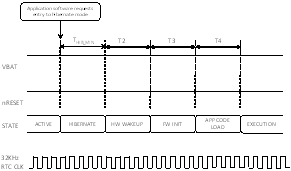ZHCSM61C November 2014 – September 2020 CC3200MOD
PRODUCTION DATA
- 1 特性
- 2 应用
- 3 说明
- 4 Functional Block Diagrams
- 5 Revision History
- 6 Device Comparison
- 7 Terminal Configuration and Functions
-
8 Specifications
- 8.1 Absolute Maximum Ratings
- 8.2 ESD Ratings
- 8.3 Power-On Hours (POH)
- 8.4 Recommended Operating Conditions
- 8.5 Power Consumption Summary
- 8.6 Brownout and Blackout Conditions
- 8.7 WLAN RF Characteristics
- 8.8 Reset Requirement
- 8.9 Thermal Resistance Characteristics for MOB and MON Packages
- 8.10 Timing and Switching Characteristics
- 9 Detailed Description
- 10Applications, Implementation, and Layout
- 11Environmental Requirements and Specifications
- 12Device and Documentation Support
- 13Mechanical, Packaging, and Orderable Information
请参考 PDF 数据表获取器件具体的封装图。
机械数据 (封装 | 引脚)
- MOB|63
散热焊盘机械数据 (封装 | 引脚)
8.10.2 Wake Up From Hibernate Timing
Table 8-3 lists the software hibernate timing requirements.
Note:
The 32.768-kHz crystal is kept enabled by default when the module goes to hibernate.
Table 8-3 Software Hibernate Timing
Requirements
| ITEM | NAME | DESCRIPTION | MIN | TYP | MAX | UNIT |
|---|---|---|---|---|---|---|
| THIB_MIN | Minimum hibernate time | The time for which the device must be held in hibernate mode | 10 | ms | ||
| T2 | Hardware wake-up time | Time taken by the hardware to initialize | 25 | ms | ||
| T3 | Firmware initiation time | Time taken by the ROM firmware to initialize the hardware | 3 | ms | ||
| T4 | Code download time | Time taken to download the code from the serial flash to on-chip RAM | Image size (KB) × 0.75 ms | |||
Figure 8-7 shows the timing diagram for wake up from the hibernate state.
 Figure 8-7 Wake Up
From Hibernate Timing Diagram
Figure 8-7 Wake Up
From Hibernate Timing Diagram